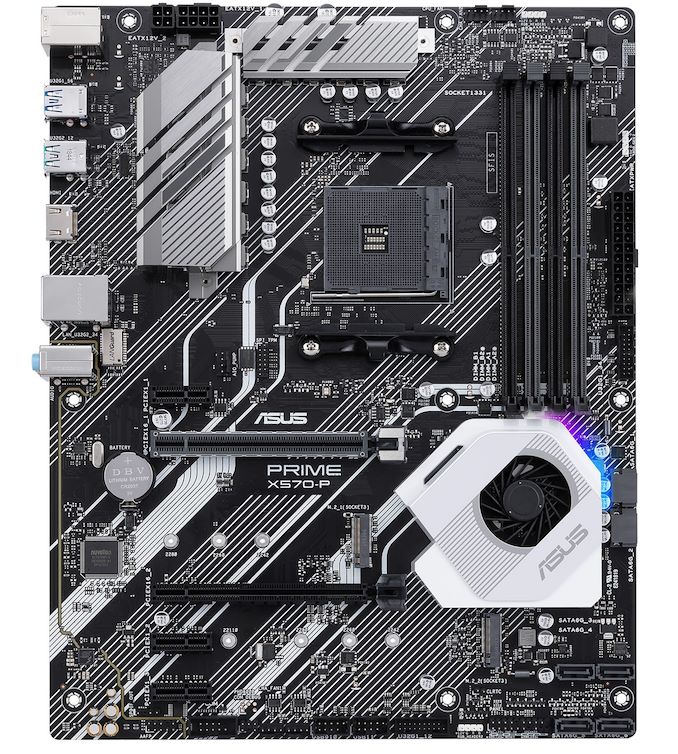The AMD X570 Motherboard Overview: Over 35+ Motherboards Analyzed
by Gavin Bonshor on July 9, 2019 8:00 AM ESTASUS Prime X570-P
Moving onto the second of the ASUS Prime series models, the ASUS Prime X570-P represents an entry-level offering to the X570 chipset with two full-length PCIe 4.0 slots, dual PCIe 4.0 M.2 slots, and a pair of budget-friendly Realtek controllers handling the onboard audio and networking. The most noticeable aspect of the board's design is how bare the PCB looks in contrast to other models from the ASUS X570 product stack.
The chipset heatsink is actively cooled with a white and silver design, while the PCB itself features a white and black design which is a trait of the Prime series itself. The Prime X570-P omits a rear panel cover entirely, and the chipset heatsink is running an 8-phase power delivery for the CPU VCore, with a seemingly adequate looking heatsink from our hands-on with this model at Computex.
On the main features, the ASUS Prime X570-P has two full-length PCIe 4.0 slots which operate at x16 and x16/x4. This is because the Ryzen 3000 series processors feed the top slot, while the bottom full-length slot lanes come directly from the X570 chipset. This means there is support for two-way AMD CrossFire multi-graphics card configurations, but none for NVIDIA SLI. For storage devices, there are two M.2 slots with support for PCIe 4.0 x4 drives, but users looking to run fast and hot running NVMe drives may need to purchase their own heatsinks as the board doesn't feature them; also included on the Prime X570-P are a total six SATA ports. Memory support is good with four memory slots with support for up to 128 GB with the 32 GB UDIMMs having been qualified by ASUS across its X570 product stack.
As expected with a more wallet-friendly model, the ASUS Prime X570-P rear panel isn't as bare as the lack of a rear panel cover would suggest with four USB 3.1 G2 Type-A, two USB 3.1 G2 Type-A, and two USB 2.0 ports. There are three 3.5 mm audio jacks which are controlled by a Realtek S1200A HD audio codec, a single Ethernet port controlled by a Realtek RTL8111H Gigabit NIC, a PS/2 combo port, and an HDMI video output for users of Ryzen APUs.
The ASUS Prime X570-P sits at the lower end of the X570 product and has an MSRP of $160. This model is designed to allow users a lower cost alternative to benefit from the X570 chipset features such as PCIe 4.0, and more native USB 3.1 G2 Type-A support; this model doesn't feature any Type-C connections, although, given the board's price, it's nothing out of the ordinary.












225 Comments
View All Comments
abufrejoval - Tuesday, July 9, 2019 - link
It's amazing how quickly you run out of PCIe lanes, when you don't have switches to multiplex and translate between PCIe revisions and lanes (e.g. PCIe v4 x2 <-> PCIe v2 x8).I find myself using USB 3.x NBase-T NICs and NVMe adapters, simply because they *do* switch.
Bensam123 - Tuesday, July 9, 2019 - link
Maybe a bit more depth on the power delivery page. I have absolutely no idea how to go about parsing what's there. More chokes is better? What denotes a power phase?A5 - Tuesday, July 9, 2019 - link
+1. Some analysis of that information would be helpful.MrSpadge - Tuesday, July 9, 2019 - link
+1bunkle - Wednesday, July 10, 2019 - link
The controller column includes the total number of phases supported split between CPU cores and SoC e.g. (6+1) = 6 CPU phase and 1 SoC phase. More is *usually* better but has diminishing returns regarding tighter and tighter voltage regulation. Some controllers are better than others (can operate at high frequency e.g. 500KHz v 1000KHz, include other features to improve performance) mitigating the need for more phases.Each phase is a buck converter comprised of a low/high side MOSFET (can be integrated in a single package) and choke. Some controllers can support doubling up the PWM signal to driver more MOSFETs. Doublers can also be added as discrete components if not built into the controller.
Current rating of the MOSFET (e.g. Sic639=40A IR3555=60A) indicates the total power deliverable. MOSFETs are not 100% efficient and vary in efficiency. The more current they provide the hotter they get and the less efficient they become, with better MOSFETs producing less heat for a given current. Thus using doubles can improve temperatures and efficiency without the benefits of the tighter voltage tolerance that *real* phases provide.
Hope that’s helpful!
bunkle - Wednesday, July 10, 2019 - link
A lot more detailed explanation: https://en.wikichip.org/wiki/voltage_regulator_mod...bug77 - Tuesday, July 9, 2019 - link
The description for AsRock X570(M) Pro4 says "5 jack + 1 SPDIF". Unfortunately, those boards lack SPDIF and only come with 3 jacks ;)Smell This - Tuesday, July 9, 2019 - link
I'm thinking the *ASRock Thunderbolt AIC* ...https://thunderbolttechnology.net/product/asrock-t...
would cover all your TBT peripheral needs, including optical.
DanNeely - Tuesday, July 9, 2019 - link
Do X570 boards still need an extra chip per USB port to support USB-C reversibility?The additional expense and needed PCB space were cited as among the reasons why earlier generation boards (IIRC both Intel and AMD) almost never had more than 1 C port; but it was never clear to me if that was an inherent implementation penalty for the C port or an artifact of Intel's tech stack being stalled out and AMD outsourcing to ASMedia which built the chipsets on an ancient (55nm) platform.
DigitalFreak - Tuesday, July 9, 2019 - link
Gavin - X370 and X470 only supported PCIe 2.0. The connection between the CPU and chipset was 3.0, but all the ports on the chipset were 2.0.